How to plant and grow bagged potatoes
Now they use many different technologies that allow you to get early potatoes, increase their productivity and quickly deal with pests. But if you have a small area or little good soil, for example, your summer cottage is located on a sandy, rocky or swampy area where it is difficult to grow many high-quality tubers, then planting potato tubers in bags will help you in this position.
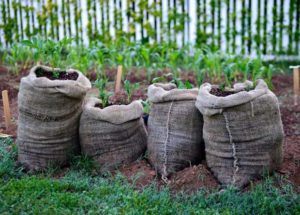
This is an unusual method, suitable for any adverse conditions. All the necessary work will require a little time and effort, but will provide you with a good harvest.
Content
The specifics of planting and growing: the advantages and disadvantages of the method
The main difference between this method is that this is not work in the garden, but planting potato tubers in bags, where the plants develop throughout the entire period. For planting tubers, both specially made bags equipped with valves for collecting tubers are suitable, as well as simple ones left over from sugar or flour.
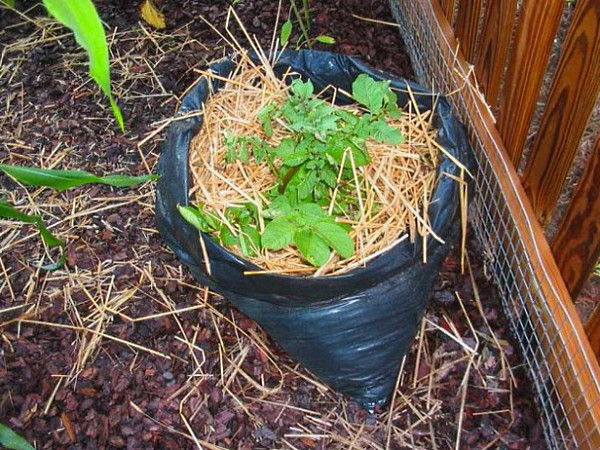
What you need to successfully grow bagged potatoes:
- nutritious and loose soil for the rapid development of potatoes;
- a sufficient amount of moisture;
- the required level of plant lighting.
For this reason, the main task of the gardener is to find a suitable place where it is convenient to place the bags. They can be slightly deepened into the ground or placed near the support.
Containers with potatoes should be:
- installed so that it is convenient to care for plants;
- they should not get moisture from the roof;
- well lit.
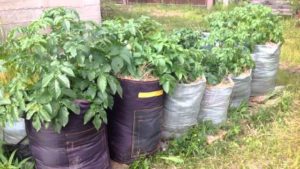
Advice! If there is no place on the site for placing bags, they can be determined under the walls of buildings (so that water does not get from the roof), near terraces or along paths in the garden.
Benefits of growing bagged potatoes:
- To create a plantation, you need a minimum of space, it can be created almost anywhere.
- Labor costs are significantly reduced - there is no need to dig up the beds, hedge bushes and destroy weeds.
- If the soil is properly prepared, then the potatoes growing in bags will hardly hurt, and pests are not afraid of him.
- Harvesting the grown tubers takes little time.
Cons of the method of planting potatoes in bags:
- It is necessary to control soil moisture all the time.
- The bags need to be securely installed.
- For a decent harvest, you need to prepare a nutritious soil.
- After growing potatoes, the land will have to be utilized somehow.
Technology for growing potatoes in bags: rules, recommendations and instructions
Bag preparation
Potatoes are planted in different bags, sometimes even garbage bags are adapted for this. It is not necessary to use the new ones, the old ones are also suitable, the main thing is that there are no large holes, and the soil is kept in them.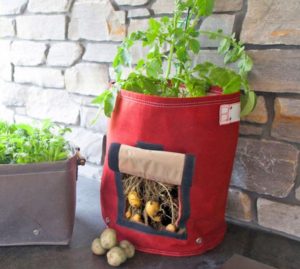
- It is good to use white bags in the southern regions, in such a container the soil heats up less. Old containers (bags) must be well cleaned.
- It is convenient to use special packages designed for potatoes, but in small towns they are difficult to find on sale. They are also expensive.
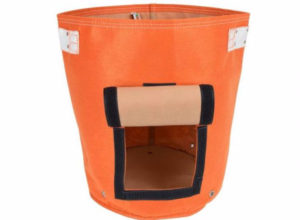
- Black polyethylene bags are available at every hardware store and are cheap.
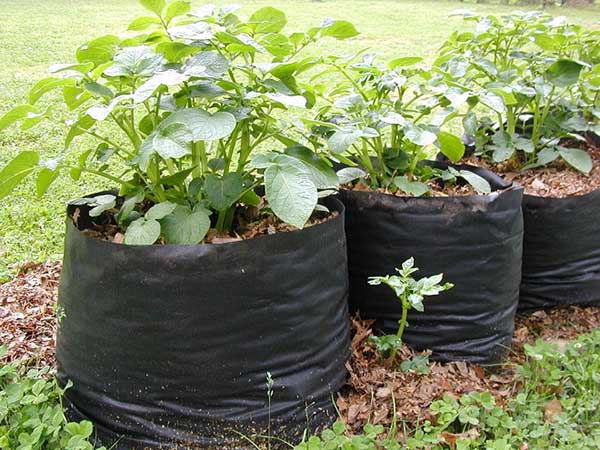
- Many have luggage bags lying around in the house; they are sometimes called "shuttle" bags. They are suitable for creating a small potato garden.
Important! The bags should have enough holes to drain excess water and to ventilate the roots.
Soil preparation
Make up a nutritious potting soil. This crop needs nutritious and light soil for proper development. In heavy soil with a high clay content, the growth of tubers is difficult. If you plant tubers in bags in February-March, or you live in the northern regions, then you need to store the soil in the fall, because in early spring the soil is still frozen.
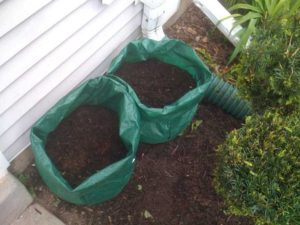
The approximate composition of the soil mixture for filling bags:
- 1 bucket of soil from a fertile garden;
- 1 bucket of humus;
- 2-3 liter cans of coarse sand;
- 1-2 liters of wood ash.
Before filling the bags, all components must be mixed well and all large inclusions must be removed - small branches, accidentally trapped stones, etc.
Important! From the area where nightshade crops grew, you can not harvest the soil.
Preparing tubers for planting
For planting, you need to choose healthy and whole tubers, weighing about 100 grams.
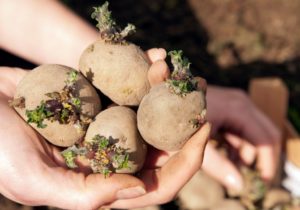
Attention! For planting in this way, you need to choose early varieties that can give a lot of tubers.
Potato planting dates
To correctly decide at what time to plant tubers in bags, you need to roughly know when you can move them outside.It is necessary to subtract 2 months from the approximate period, this time the potatoes are able to develop without sunlight and form powerful roots. If it is not possible to keep the developing tubers in a protective structure and you will plant potatoes in bags immediately on the street, then work should be started after the average daily temperature does not drop below 12 degrees.
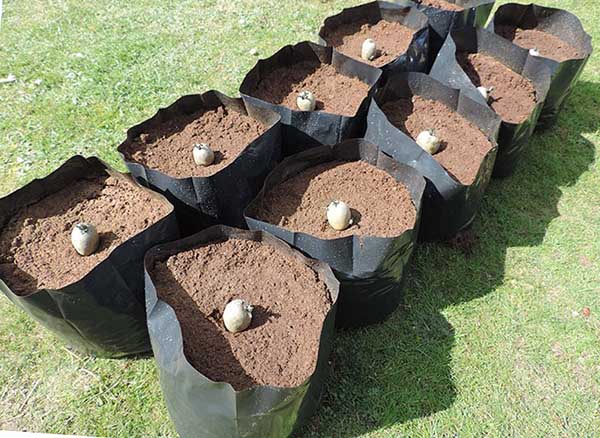
Step-by-step instructions for planting potatoes in bags
If you will be carrying bags with plants, then prepare a hard bottom so as not to injure the root system when carrying.
- They begin planting tubers in bags with the creation of an effective drainage layer; for this, a layer of at least 15 cm of drainage material is poured. Small cobblestones, large crushed stone or gravel, crushed stone are suitable as drainage.
- A layer of soil 20-30 cm thick is poured onto the drainage, lightly tamping it. 2-3 tubers or several parts of a tuber with eyes are placed on it (it is good to treat them with insecticides before that). The potatoes are covered with a 15-20 cm layer of soil. The earth is moderately moistened; at first, high humidity is not needed for potatoes. Potatoes, planted directly on the street, are first covered with dense material to reduce moisture evaporation.
- When the sprouts appear (after 8-14 days) and rise 10-15 cm above the ground, they begin to fall asleep to the very leaves until the height of the soil in the bag reaches 50-60 cm.This method provokes the appearance of new roots on the stems potatoes, on which additional tubers are then formed. After that, it is necessary to rearrange the bag to the light; now, for proper development, the shoots will need a lot of light.
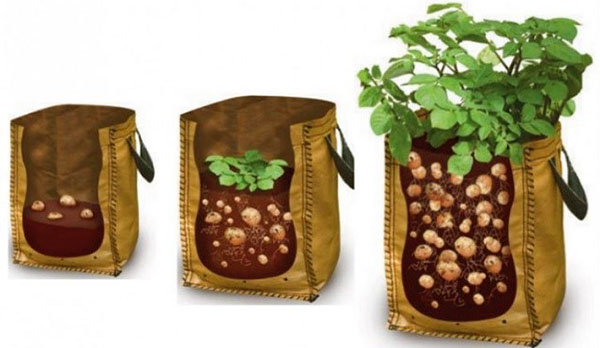
Advice! It is not worth pouring too much soil, as the tubers do not have enough strength to form too many roots.
Caring for bagged potatoes
Potatoes growing in bags require timely watering, loosening the soil, fertilizing and fighting harmful insects. Watering is necessary about once a week, depending on the moisture content of the soil, well moistening the soil. It is necessary to control the condition of the drainage - moisture should not stagnate. The soil needs to be fluffed once a week a short time after watering. In order not to do this work, the soil can be mulched.
Do not forget that because of the large area of moisture evaporation, you will have to water the bags of potatoes more often and more than in a regular garden. Water is extremely necessary for plants during the formation of inflorescences and during the growth of the crop. Experienced gardeners pay attention to the need for watering with moistening of all the soil in the bag.
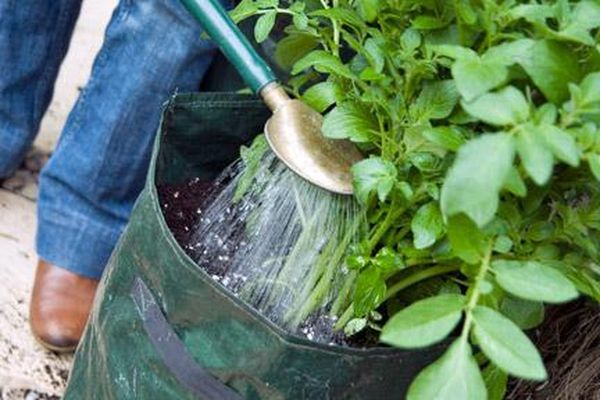
If the bags are made of too dense material, then it is advisable to make additional small cuts in the bottom before planting the tubers. A special valve located at the bottom will greatly facilitate the collection of young tubers and will help aerate the roots.
Top dressing for potatoes
Moderate potassium fertilization has a beneficial effect on the quality and quantity of the crop. Excess nitrogen in top dressing will only harm, since the tubers will not ripen well, and a thin skin will form on them, which will greatly complicate the storage of potatoes.
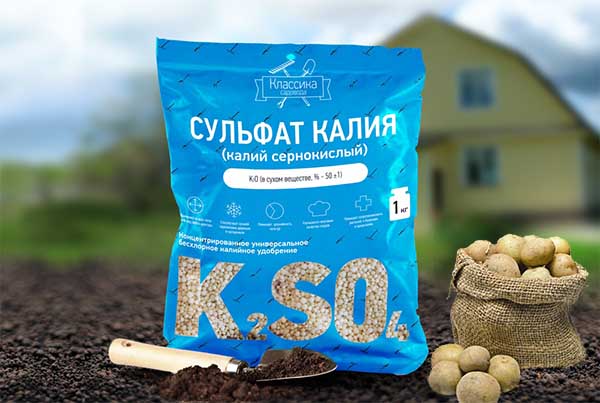
Advice! To harvest a high yield, it is necessary to fertilize the growing potatoes with potassium sulfate.
Any feeding should be done only after watering. For each bag, it is enough to pour ½ a bucket of any of the following compounds, and then sprinkle the leaves from a watering can with a strainer on top.
Natural formulations for feeding bagged potatoes:
- "green manure. Pour fresh grass on which seeds have not yet appeared in a suitable container. Any greens will do - dandelions, burdock leaves, nettle greens, any weeds with roots and soil adhering to them so that bacteria appear in the mixture. It is permissible to add a little of last year's leaves, hay and onion husks. Fill the container with water and soak for 1-2 weeks, sometimes stirring the composition.The fertilizer will be completely ready for use, after a brown mass with an unpleasant odor appears in the bucket, and the grass turns into mucus, only thick pieces remain. Add 2 liters of this slurry to a bucket of water and pour bags of potatoes;
- bird droppings. Fill ¼ part of a bucket with droppings, fill it completely with water, and hold for a week. Add 500 ml of this infusion to 10 liters of water and pour;
- mullein. Prepare in the same way as bird droppings, only 1 liter of infusion is poured into a bucket of water before feeding;
- infusion of ash. Take ½ cup of ash and simply pour it onto the soil in a bag, then loosen the soil. This is an additional top dressing that improves the quality of organic fertilizers; it should be used 5–7 days after organics. The reason is that the alkali from the wood ash and the nitrogen of the fertilizer will react chemically. Ammonia will begin to evaporate from the top dressing, the potatoes will not receive many necessary elements.
Diseases and pests of potatoes when grown in bags
You need to often inspect the bushes of growing potatoes in order to immediately detect pests that have appeared. In addition to the long-familiar Colorado potato beetle, different types of ticks and aphids can appear on them. But with this technology, pests and diseases almost do not touch potatoes, but ants annoy them.
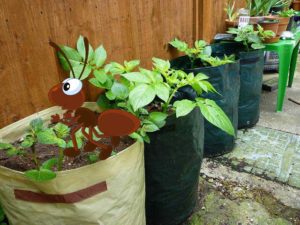
How to get rid of ants in sacks of potatoes
Ants love warm places and constantly try to arrange their home in a greenhouse, a wooden box, even crawl under cut plastic bottles that protect seedlings in the garden. Bags in the sun will be a good home for these insects. Lots of ants will spoil the fun you can get from growing potatoes. It is difficult to remove these tenants, for this reason it is advisable to carry out preventive measures:
- Sprinkle ant poison around the bags, such as Anteater.
- Sprinkle the bagged soil with dry mustard or ground pepper.
- Move more often, water the "container", it is necessary to disturb the first appeared ants as often as possible.
Harvesting
Greens on potato bushes begin to dry in the first decade of August. This suggests the potatoes can be harvested, so turn the bag over and shake out the soil. Select and dry the potatoes in the sun, then you can put them in storage.
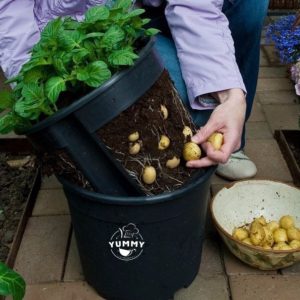
Under favorable conditions, it is possible to collect from one bag (4-5 initial tubers) from 1 to 5 kg of good potatoes. The method of growing in bags is used not only when there is a lack of space, it will help those who want to get the maximum amount of products from their site. The main thing is that with this method you can get a decent harvest of potatoes in almost any conditions.

